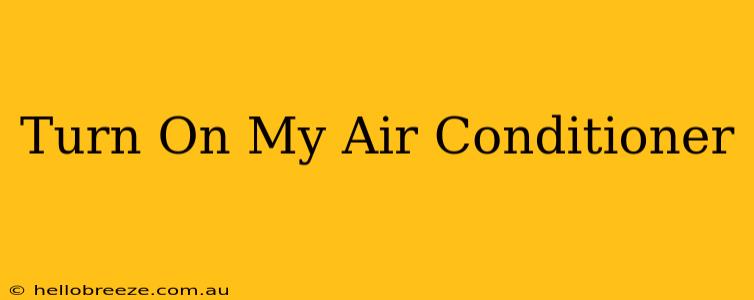Summer's heat got you down? Learning how to turn on your air conditioner might seem simple, but there are a few things to consider depending on your system. This guide will walk you through the process, ensuring you're cool and comfortable in no time.
Locating Your Air Conditioner's Power Source
Before you even think about cool air, you need to make sure your AC unit is receiving power. This might seem obvious, but it's the first and most important step!
Step 1: Check the Circuit Breaker
Many air conditioners are connected to a dedicated circuit breaker in your electrical panel. Look for a breaker labeled "AC," "Air Conditioner," or something similar. If the breaker is tripped (switched to the "off" position), carefully flip it back to the "on" position. If the breaker keeps tripping, there might be a problem with your unit – contact a qualified technician.
Step 2: Examine the Thermostat
Your thermostat controls the power to your air conditioner. Make sure it's turned on and set to the "Cool" mode. If it's showing "Off," "Heat," or "Auto," switch it to "Cool." Many newer thermostats have digital interfaces, offering more precise temperature control. Some even connect to your home's Wi-Fi, allowing you to control your AC from your smartphone!
Step 3: Check the Power Cord (Window Units Only)
If you have a window air conditioner, ensure the power cord is securely plugged into a working wall outlet. Make sure the outlet isn't overloaded with other appliances.
Setting Your Desired Temperature
Once your AC unit is receiving power, it's time to set the temperature. Remember, setting the temperature too low won't cool your home faster; it simply increases energy consumption.
Finding the Sweet Spot
A comfortable temperature is generally between 72°F and 78°F (22°C and 26°C). Experiment to find the perfect balance between comfort and energy efficiency. Consider using programmable thermostats to automate temperature adjustments throughout the day.
Troubleshooting Common Issues
If your air conditioner still isn't working after following these steps, you may have a more serious problem:
- Check the air filter: A clogged air filter restricts airflow and reduces efficiency. Replace or clean the filter regularly.
- Listen for unusual noises: Unusual noises like banging, rattling, or squealing could indicate a mechanical problem.
- Inspect the outdoor unit (for central AC systems): Ensure the outdoor unit is clear of debris and has good airflow. Never touch the unit while it's running.
If you've tried these troubleshooting steps and your air conditioner still isn't working, it's best to call a qualified HVAC technician for assistance. They have the expertise to diagnose and repair more complex issues.
Maintaining Your Air Conditioner for Optimal Performance
Regular maintenance will prolong the life of your air conditioner and keep it running efficiently. This includes:
- Regular filter changes: Change the air filter every 1-3 months, depending on usage and filter type.
- Annual professional maintenance: Schedule a yearly inspection and tune-up by a qualified HVAC technician.
By following these simple steps and practicing regular maintenance, you can ensure your air conditioner keeps you cool and comfortable throughout the hottest summer months. Remember, a properly functioning air conditioner can significantly impact your comfort and energy bills.

